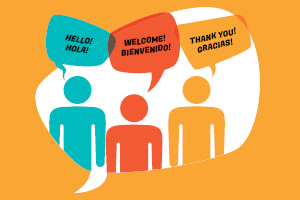 The Community Spanish Interpreter curriculum prepares individuals to work as entry-level bilingual professionals who will provide communication access in interview and interactive settings. In addition, this curriculum provides educational training for working professionals who want to acquire Spanish language skills.
The Community Spanish Interpreter curriculum prepares individuals to work as entry-level bilingual professionals who will provide communication access in interview and interactive settings. In addition, this curriculum provides educational training for working professionals who want to acquire Spanish language skills.
Coursework includes the acquisition of Spanish: grammar, structure, and sociolinguistic properties, cognitive processes associated with interpretation between Spanish and English; the structure and character of the Hispanic community; and acquisition of communication skills.
Graduates should qualify for entry-level jobs as para-professional bilingual employees in educational systems or a variety of community settings. Individuals may choose from part-time, full-time, or self-employment/free-lance positions, or apply language skills to other human service related areas.
Program Requirements
Community Spanish Interpreter Degree and Certificate Requirements
Resources
- American Translators Association (ATA) Membership Information
- Carolina Association of Translators and Interpreters (CATI) Membership Information
- How to Become a Healthcare Interpreter
- How to Become a Certified Medical Interpreter
- How to Become a Federal Court Interpreter
- Resources for Current and Prospective Court Interpreters
- Career Resources for Community Spanish Interpreter Students and Recent Graduates
For more information contact:

Community Spanish Interpreter Instructor
Department: Faculty
Phone: (252) 246-1354
Email: lbenavent@wilsoncc.edu
Office: D204
Frequently Asked Questions
The length of time to complete the Community Spanish Interpreter (A.A.S.) degree or certificate depends on the number of pre-requisite math and English courses students must take, the time at which students are admitted into the program, and the number of courses students take each semester. Students are admitted in fall, spring, and summer semesters, but specific courses are only offered once a year. Full-time students can finish the degree in two years if they follow the sequence set forth in the plan of student, which requires students to take courses in the summer.
Certificate students are able to earn their certificate in one year (including summer courses). Once students complete the prerequisites, they should be able to complete the certificate in three semesters (one year) by taking 2-3 courses each semester.
In order to have the best idea of exactly how long the program will take, it is recommended that you apply, have your transcripts sent for evaluation, and then follow up with your program advisor who can provide you with a personalized, semester-by-semester plan outlining the specific courses you would need to take. That plan would include an “anticipated graduation” date.
Community Spanish Interpreter program courses are offered in a variety of formats, including online, in-person, and hybrid (both online and in-person). When program classes meet on campus, it is usually 1-2 days per week. Most online courses are asynchronous which means students are not required to be present online at a specific time.
Once students graduate with a Community Spanish Interpreter (A.A.S.) degree, students do not need to pass a test or earn a license to seek employment in the field of interpreting and translation. Most employers do not require their employees to be certified; however, there are some professions, such as medical and court interpreters that may require the employee to pass an exam after graduation and earn a specific certification. There are several nationally accredited certifications. For more information visit the <em>Community Spanish Interpreter Resources</em> page.
Graduates should qualify for entry-level jobs as para-professional bilingual employees in educational systems or a variety of community settings. Individuals may choose from part-time, full-time, or self-employment/free-lance positions, or apply language skills to other human service-related areas. Career opportunities for Spanish Interpreters include Social Work, Human Resources, Immigration Specialists, and Teachers.
No, even though some knowledge of Spanish is always helpful, the program has a diversity of students with no prior knowledge of the Spanish language. Both types of students are successful in completing the degree or certificate program.
